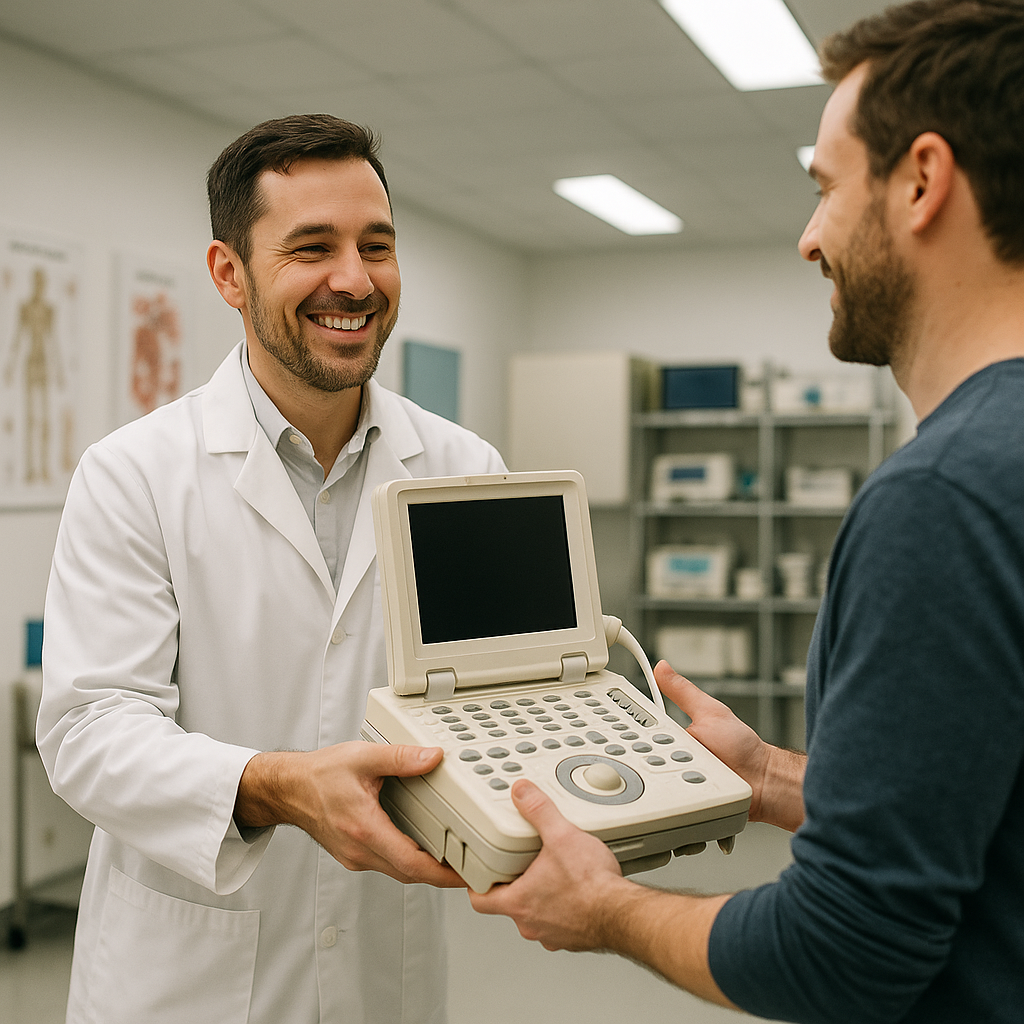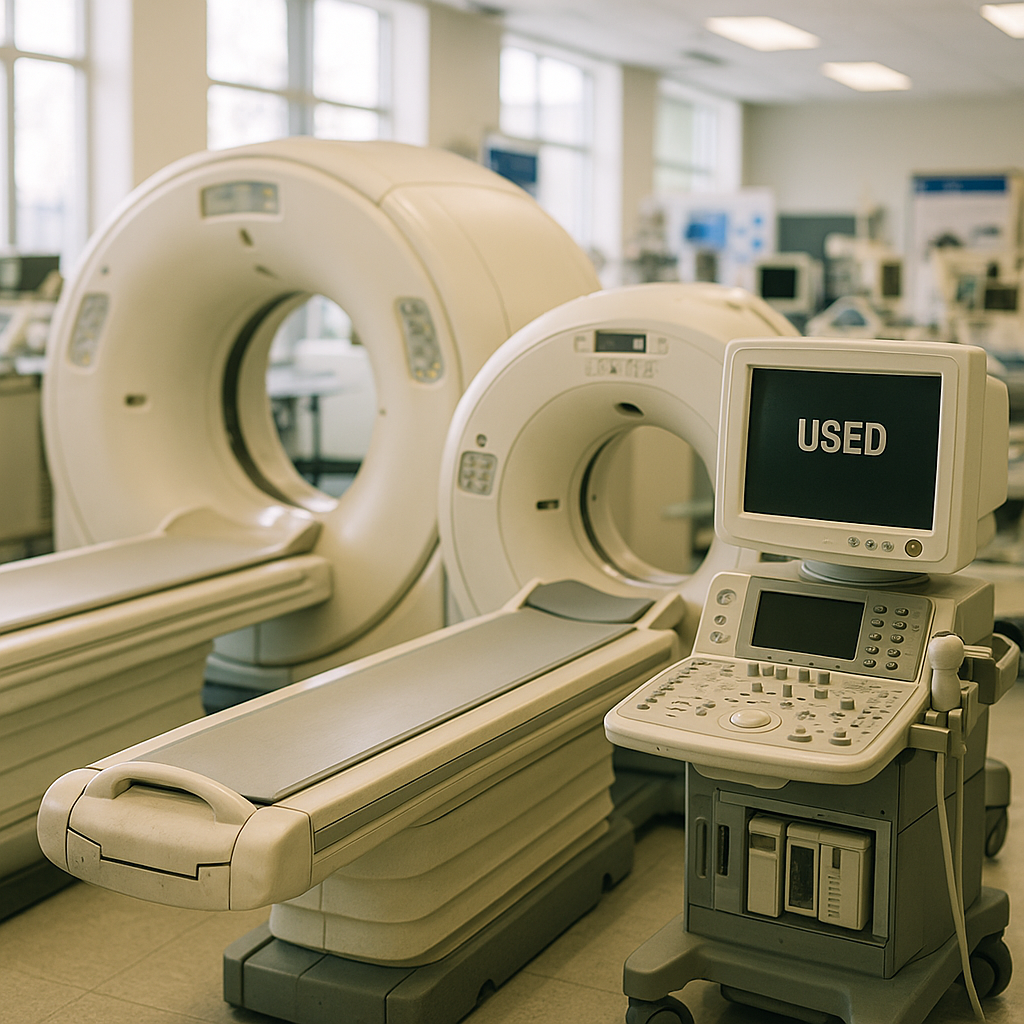5901 Botham Jean Blvd, Dallas, TX 75215
What is the Market for Used Diagnostic Imaging Equipment?
September 9, 2025The global market for used and refurbished diagnostic imaging equipment is thriving, valued at approximately $5 billion in 2023 and projected to grow at a compound annual growth rate (CAGR) of 7.5-10.4% through 2030. This robust marketplace includes a wide range of medical imaging technology, such as MRI machines, CT scanners, X-ray systems, and ultrasound devices. Healthcare facilities worldwide are increasingly turning to refurbished equipment as a cost-effective alternative to new purchases.
The appeal is clear: refurbished diagnostic imaging devices typically cost 30-50% less than new equipment while maintaining comparable quality and performance standards. This significant price difference makes advanced imaging capabilities accessible to smaller hospitals, independent imaging centers, and medical practices with constrained budgets. Major healthcare technology companies like GE Healthcare, Siemens Healthineers, and Philips Healthcare have established dedicated refurbishment programs. Additionally, specialized firms such as Block Imaging, Nationwide Imaging, and Atlantis Worldwide focus exclusively on acquiring, refurbishing, and distributing pre-owned imaging equipment.
North America currently dominates this market with nearly a 48% share, though the Asia-Pacific region is experiencing the fastest growth. Rising healthcare costs, an increased focus on sustainability, and improvements in refurbishment quality standards are driving global demand. For healthcare providers seeking to balance advanced diagnostic capabilities with financial constraints, the refurbished imaging equipment market offers a compelling solution that shows no signs of slowing down.
What are the Benefits of Selling Used Imaging Equipment?

Healthcare facilities aiming to divest older diagnostic imaging equipment can reap significant advantages in today’s market. Selling used medical imaging devices offers multiple benefits beyond just making room for newer technology.
Financial Recovery and Capital Generation
Medical imaging equipment represents a substantial investment for any healthcare provider. CT scanners, MRI machines, and other devices often cost hundreds of thousands or even millions of dollars when new. Selling them helps recover part of your initial investment instead of letting these valuable assets sit unused when replaced.
Funds from selling used imaging equipment can offset the cost of acquiring newer technology. This creates a practical funding cycle that enables healthcare facilities to stay current with technological advances without bearing the complete financial burden of constant upgrades.
Many facilities find that selling their older equipment provides the capital needed to invest in other essential areas. Whether funding staff training programs or facility improvements, revenue from equipment sales can be strategically reinvested.
Environmental Sustainability
Selling used imaging equipment significantly contributes to sustainable practices in healthcare. These sophisticated devices contain valuable components and materials that can be reused rather than discarded. Extending the useful life of imaging equipment helps reduce electronic waste and conserves the resources required to manufacture new devices.
The medical industry generates nearly six million tons of waste annually. Every imaging device given a second life in another facility represents a meaningful reduction in that environmental footprint. This aligns with growing expectations for healthcare organizations to demonstrate environmental responsibility in all aspects of their operations.
Market Accessibility and Global Impact
Selling used imaging equipment helps make advanced diagnostic technology more accessible to a wider range of healthcare providers. Smaller clinics, independent practices, and facilities in developing regions often cannot afford new imaging systems but can provide quality care with well-maintained pre-owned equipment.
This ripple effect extends the impact of your original investment beyond your facility. A CT scanner or MRI machine that’s no longer cutting-edge for a major hospital can still offer life-saving diagnostic capabilities in settings where such technology would otherwise be unavailable.
Simplified Selling Process
Companies specializing in the used medical equipment market have streamlined the selling process significantly. These organizations typically handle everything from equipment evaluation and fair market pricing to deinstallation, transportation logistics, and delivery to the new owner.
This turnkey approach removes the complexity that might otherwise discourage healthcare facilities from selling their used equipment. You can focus on your core mission of patient care while a specialized vendor manages the details of the equipment sale.
Professional Project Management
Working with reputable used equipment dealers allows healthcare facilities to benefit from professional project management throughout the selling process. Experienced teams coordinate with facility staff to minimize disruption during equipment removal and ensure the proper handling of sensitive technology.
These specialists understand both the technical aspects of imaging equipment and the unique needs of healthcare environments. Their expertise ensures a smooth transition as equipment changes hands, with proper documentation and compliance with regulatory requirements.
How Does the Selling Process Typically Work?
The selling process for used diagnostic imaging equipment is designed to be straightforward for healthcare facilities. Specialized buyers have streamlined procedures to minimize disruption and maximize your returns.
When selling diagnostic imaging equipment, the process typically follows these key steps:
1. Initial Contact and Assessment
The process begins when you contact a specialized buyer or broker specializing in used medical imaging equipment. These experts understand the technical specifications and market value of various systems. They’ll request basic information about your equipment, such as the manufacturer, model, year of manufacture, and operational status.
2. Equipment Valuation
Based on the information provided, the buyer will assess the equipment’s value. Many companies offer free, no-obligation quotes. The valuation considers factors like age, condition, software version, and current market demand. Some buyers may request photos or schedule an on-site inspection for high-value items like MRI or CT scanners.
3. Formal Offer and Agreement
After the assessment, the buyer will present a formal offer outlining the purchase price and transaction terms. Once you accept, a formal agreement details both parties’ responsibilities, including payment terms and logistical arrangements.
4. De-installation and Removal
Professional buyers handle the complex task of de-installing the equipment. This requires technical expertise to safely disconnect, disassemble, and remove the systems without damaging them or your facility. The buyer coordinates with facility management to minimize disruption and schedule the work at convenient times.
5. Transportation and Logistics
After de-installation, the buyer manages transportation logistics, including proper crating, loading, and securing the equipment for transit. Specialized transportation may be needed for sensitive equipment like MRI machines or CT scanners. Reputable buyers carry insurance to protect the equipment during this phase.
6. Final Payment and Documentation
Once the equipment is successfully removed, you’ll receive the final payment as specified in your agreement. The buyer will also provide documentation confirming the transfer of ownership and, if applicable, certificates verifying proper disposal of components to comply with environmental regulations.
Throughout the process, experienced buyers emphasize their project management capabilities, handling all details from initial assessment to final removal. This comprehensive approach ensures a hassle-free experience, allowing healthcare providers to focus on their core operations while the equipment transition is professionally managed.
For facilities with multiple pieces of equipment or those undergoing complete department upgrades, many buyers can develop customized project plans that align with your equipment replacement schedule, ensuring continuous patient care with minimal downtime.
What Types of Equipment are in Highest Demand?

The secondary market for diagnostic imaging equipment consistently demands several key modalities. These systems maintain their value due to their essential role in healthcare. Understanding which equipment is most sought-after helps facilities make informed decisions about investments and recycling opportunities.
MRI machines and CT scanners lead the market in demand and value retention. Industry data indicates MRI machines constitute approximately 46% of the global secondary market for medical imaging equipment outside the United States. Their advanced imaging capabilities and high initial cost make them particularly valuable in the used equipment market.
Despite being older technology, X-ray systems still command about 13% of the refurbished market share. Their widespread use in various healthcare settings contributes to their continued demand. Ultrasound devices, valued for their portability and versatility, represent roughly 18% of the refurbished equipment market.
The following high-demand diagnostic imaging equipment types serve diverse medical needs:
- MRI machines: Provide detailed images of soft tissues using magnetic fields and radio waves, without radiation exposure.
- CT scanners: Generate cross-sectional body images using X-rays, essential for trauma assessment and detailed bone imaging.
- X-ray systems: Offer quick, accessible imaging for bone structures and some soft tissues.
- Ultrasound devices: Use sound waves to create real-time images, ideal for obstetrics, cardiology, and point-of-care diagnostics.
- C-arms: Mobile X-ray equipment for real-time imaging during surgeries and interventional procedures.
- PET/CT scanners: Combine functional and anatomical imaging, primarily used in oncology and neurology.
- Mammography units: Specialized X-ray systems designed specifically for breast imaging.
Market demand can fluctuate based on technological advances, healthcare policy changes, and regional needs. However, these core imaging modalities consistently maintain their value in the secondary market. Their long operational lifespan makes them ideal candidates for refurbishment, with MRI systems having a 95% refurbishment potential and CT scanners at 85%.
The global market for refurbished medical imaging equipment is growing rapidly, with projections showing an increase from approximately $11 billion in 2020 to over $21 billion by 2027. This growth highlights the economic and environmental benefits of extending the life cycle of these valuable medical assets through proper recycling and refurbishment programs.
Conclusion: Key Considerations When Selling Used Imaging Equipment
Selling used diagnostic imaging equipment involves thoughtful planning and selecting the right partner. Collaborating with reputable buyers who provide fair market value is crucial for maximizing your investment returns. The best buyers offer industry experience, robust refurbishment capabilities, and global distribution networks to place your equipment where it’s most needed.
For healthcare providers aiming to recycle imaging assets, the choice of partner is critical. Contact Okon Recycling at 214-717-4083 for expert guidance throughout the entire process of selling your used imaging equipment.
